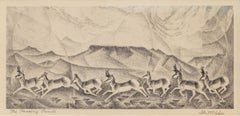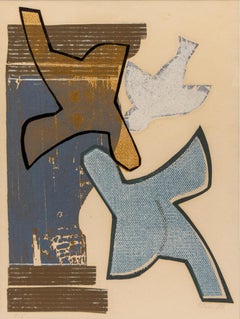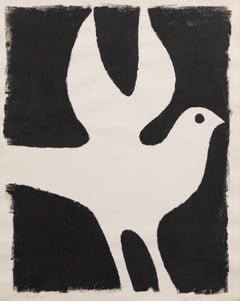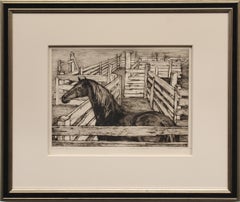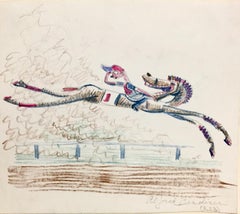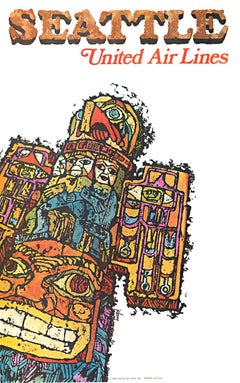David Cook Galleries Animal Prints
to
1
2
1
1
Overall Width
to
Overall Height
to
5
2
1
5
2
1
3
2
2
2
1
1
1
1
1
1
1
1
1
1
3
1
1
5
5
5
The Passing Parade, 20th Century Lithograph, Southwestern Desert with Antelope
By Ila Mae McAfee
Located in Denver, CO
This stunning original lithograph, titled The Passing Parade, is a signed piece by renowned American artist Ila Mae McAfee (1897-1995). Created in the 20th century, the artwork depic...
Category
20th Century American Modern Animal Prints
Materials
Lithograph
Original Signed 1970s Blue Birds Colored Lithograph - Mid Century Modern Artwork
Located in Denver, CO
This vintage original lithograph by renowned artist Mary Chenoweth features an abstract depiction of birds in flight, showcasing her unique technique of layering various textures of ...
Category
1970s American Modern Animal Prints
Materials
Lithograph
Ethel Magafan Modernist Rodeo Lithograph "Riding the Brahmas", Signed, Framed
By Ethel Magafan
Located in Denver, CO
Discover the raw energy and bold style of acclaimed Colorado artist Ethel Magafan with this original modernist lithograph titled Riding the Brahmas. This striking mid-20th-century pr...
Category
Mid-20th Century American Modern Animal Prints
Materials
Lithograph
"Bird #2" - 1949 Vintage Black & White Modernist Monotype Print by Edgar Britton
Located in Denver, CO
Bird #2 is a striking vintage black-and-white monotype print by renowned Colorado artist Edgar Britton. Created in 1949, this original work features a bold composition of a white dov...
Category
1940s American Modern Animal Prints
Materials
Monotype
Corralled Horse, 1940s WPA-Era American Modernist Etching, Artist’s Proof
By Ethel Magafan
Located in Denver, CO
"Corralled Horse" is a 1940s WPA-era modernist etching by acclaimed American artist Ethel Magafan (1916–1993), renowned for her dynamic murals and evocative depictions of the America...
Category
1940s American Modern Figurative Prints
Materials
Etching
Related Items
Horse Laugh
By Alfred Bendiner
Located in New York, NY
Alfred Bendiner (1899-1964) was trained as an architect but worked as an artist throughout his career. He was a noted lithographer, as well an author, muralist, and caricaturist. The...
Category
Mid-20th Century American Modern Animal Prints
Materials
Crayon
Seattle United Air Lines original vintage travel poster
Located in Spokane, WA
Original excellent condition, linen backed United Airlines: Seattle, the 1968 airplane airline aviation travel poster promoting travel to Seattle, Washington aboard United Airlines and featuring art of a Native American Indian totem pole...
Category
1960s American Modern Animal Prints
Materials
Offset
Original Fly TWA India vintage travel poster David Klein
By David Klein
Located in Spokane, WA
Original Fly TWA India vintage travel poster. Artist: David Klein. Archival linen backed in very fine condition, ready to frame.
This poster features a...
Category
1960s American Modern Animal Prints
Materials
Offset
$999
H 40 in W 25 in D 0.05 in
Kiki Smith Lithograph/Collage Various Flying Creatures "bee" Signed Dated
By Kiki Smith
Located in Detroit, MI
A collage lithograph from her series Various Flying Creatures by Kiki Smith titled: "bee." Smith has used one of her animal/insect iconic figures for this glassine paper and wove pap...
Category
1990s American Modern Animal Prints
Materials
Paper, Lithograph
$1,500
H 19.75 in W 16.5 in
Bernard Buffet - Homage to Dufy - Lithograph
By Bernard Buffet
Located in Collonge Bellerive, Geneve, CH
(after) Bernard Buffet
Lithograph after a watercolor, published in the book "Lettre à mon peintre Raoul Dufy." Paris, Librairie Académique Perrin, 1965.
Printed signature
Dimension...
Category
1940s Fauvist Animal Prints
Materials
Lithograph
$1,435
H 11.82 in W 9.45 in D 0.04 in
Jean Cocteau - The Elegant Toreador - Original Lithograph
By Jean Cocteau
Located in Collonge Bellerive, Geneve, CH
Original Lithograph by Jean Cocteau
Title: The Elegant Toreador
1961
Dimensions: 28 x 38 cm
Lithograph made for the portfolio "Gitans et Corridas" published by Société de D...
Category
1960s Modern Animal Prints
Materials
Lithograph
$956
H 11.03 in W 14.97 in D 0.04 in
Alexander Calder Circus Reproduction Lithograph After a Drawing
By (after) Alexander Calder
Located in Surfside, FL
(after) Alexander Calder
"Calder's Circus" offset lithograph on wove paper after drawings by the artist
Published by Art in America and Perls gallery in 1964 (from drawings done in the 1930's)
these range slightly in size but they are all about 13 X 17 inches (with minor variations in size as issued.) These have never been framed. The outer folio is not included just the one lithograph.
James Sweeny from the introduction “The fame of Calder’s circus spread quickly between the years 1927 and 1930. All the Paris art world came to know it. It brought him his first great personal success. But what was more important, the circus also provided the first steps in Calder’s development as an original sculptor”
Clive Gray wrote ”A visit to the studio of Alexander Calder led to the chance discovery of some hundred masterful circus drawings completed over thirty years ago. We publish, for the first time, a choice of sixteen from that group.” With signed introduction by Miro.
These whimsical drawings, done in the style of wire sculpture, include acrobats, clowns, jugglers, trapeeze artists, an elephant, dog and lion. they are great.
Alexander Calder is widely considered to be one of the most important American sculptors of the 20th century. He is best known for his colorful, whimsical abstract public sculptures and his innovative mobiles, kinetic sculptures powered by motors or air currents, which embraced chance in their aesthetic. Born into a family of accomplished artists, Calder's work first gained attention in Paris in the 1930s and was soon championed by the Museum of Modern Art in New York, resulting in a retrospective exhibition in 1943. Major retrospectives were also held at the Solomon R. Guggenheim Museum (1964) and the Museum of Contemporary Art, Chicago (1974). Calder’s work is in many permanent collections, most notably in the Whitney Museum of American Art, but also the Guggenheim Museum; the Museum of Modern Art; the National Gallery of Art, Washington, D.C.; and the Centre Georges Pompidou. He produced many large public works, including .125 (at JFK Airport, 1957), Pittsburgh (Carnegie International prize winner 1958, Pittsburgh International Airport) Spirale (UNESCO in Paris, 1958), Flamingo and Universe (both in Chicago, 1974), and Mountains and Clouds (Hart Senate Office Building, Washington, D.C., 1976). Although primarily known for his sculpture, Calder was a prodigious artist with a restless creative spirit, whose diverse practice included painting and printmaking, miniatures (such as his famous Cirque Calder), children’s book illustrations, theater set design, jewelry design, tapestry and rug works, and political posters. Calder was honored by the US Postal Service with a set of five 32-cent stamps in 1998, and received the Presidential Medal of Freedom, posthumously in 1977, after refusing to receive it from Gerald Ford one year earlier in protest of the Vietnam War.
Calder moved to New York and enrolled at the Art Students League, studying briefly with Thomas Hart Benton, George Luks, Kenneth Hayes Miller, and John Sloan. While a student, he worked for the National Police Gazette where, in 1925, one of his assignments was sketching the Ringling Bros. and Barnum & Bailey Circus. Calder became fascinated with the action of the circus, a theme that would reappear in his later work.
In 1926, Calder moved to Paris, enrolled in the Académie de la Grande Chaumière, and established a studio at 22 rue Daguerre in the Montparnasse Quarter. In June 1929, while traveling by boat from Paris to New York, Calder met his future wife, Louisa James (1905-1996), grandniece of author Henry James and philosopher William James. They married in 1931. While in Paris, Calder met and became friends with a number of avant-garde artists, including Fernand Léger, Jean Arp, and Marcel Duchamp. Cirque Calder (on view at the Whitney Museum of American Art at present) became popular with the Parisian avant-garde. He also invented wire sculpture, or "drawing in space," and in 1929 he had his first solo show of these sculptures in Paris at Galerie Billiet. Hi! (Two Acrobats) in the collection of the Honolulu Museum of Art is an early example of the artist's wire sculpture. The painter Jules Pascin, a friend of Calder's from the cafes of Montparnasse, wrote the preface to the catalog. A visit to Piet Mondrian's studio in 1930, where he was impressed by the environment-as-installation, "shocked" him into fully embracing abstract art, toward which he had already been tending.
Dating from 1931, Calder’s sculptures of discrete movable parts powered by motors were christened “mobiles” by Marcel Duchamp, a French pun meaning both "motion" and "motive." At the same time, Calder was also experimenting with self-supporting, static, abstract sculptures, dubbed "stabiles" by Jean Arp in 1932 to differentiate them from mobiles.
Public commissions increasingly came his way in the 1960s. Notable examples are .125 for JFK Airport in 1957, Spirale for UNESCO in Paris 1958 and Trois disques, commissioned for Expo 67 in Montreal, Quebec, Canada. Calder's largest sculpture at 25.7 meters high was El Sol Rojo, constructed outside the Aztec Stadium for the 1968 Summer Olympics "Cultural Olympiad" events in Mexico City. Many of his public works were commissioned by renowned architects; I.M. Pei commissioned his La Grande Voile (1966), a 25-ton, 40-foot high stabile for the Massachusetts Institute of Technology.
Part of Calder's repertoire includes pivotal stage sets for more than a dozen theatrical productions, including Nucléa, Horizon, and most notably, Martha Graham’s Panorama (1935), a production of the Erik Satie symphonic drama Socrate (1936), and later, Works in Progress (1968).
In addition to sculptures, Calder painted throughout his career, beginning in the early 1920s. He picked up his study of printmaking in 1925, and continued to produce illustrations for books and journals.As Calder’s professional reputation expanded in the late 1940s and 1950s, so did his production of prints. Masses of lithographs based on his gouache paintings hit the market, and deluxe editions of plays, poems, and short stories illustrated with fine art prints by Calder became available for sale.
One of Calder's most celebrated and unconventional undertakings was a commission from Dallas-based Braniff International Airways to paint a full-size Douglas DC-8-62 four-engined jet as a "flying canvas."
Calder created over 2,000 pieces of jewelry over the course of his career, many of them as gifts for friends and relatives. For his lifelong friend Joan Miró, he set a shard of a broken porcelain vessel in a brass ring. Peggy Guggenheim received enormous silver mobile earrings and later commissioned a hammered silver headboard...
Category
1930s American Modern Animal Prints
Materials
Lithograph
Jon Corbino, Montana Earthquake, 1936, lithograph
By Jon Corbino
Located in New York, NY
Works by Jon Corbino (1905-1964) feature drama. Here he's showing us the chaos produced by a major earthquake in rural Montana in 1936 -- an actual historical event.
The horses (ear...
Category
1930s American Modern Figurative Prints
Materials
Lithograph
Original Coppertone suntan lotion vintage poster - Italian
Located in Spokane, WA
Original “Coppertone” Colore di Rame vintage Italian poster. Colore de Rame translates into the color of copper.
Abbronzatevi! (suntan)
Non bruciatevi! (don’t burn)
Archival linen-backed in fine condition, ready to frame.
This original Coppertone poster is in A condition.
The background in the poster is a brighter yellow; after all, it is a sunny day, and you need suntan lotion!
Coppertone is an American suntan cream. Interestingly, the American poster of this famous little girl and dog...
Category
1960s American Modern Nude Prints
Materials
Offset
$1,598
H 55 in W 39 in D 0.05 in
Original New Orleans Jazz & Heritage Festival vintage poster
Located in Spokane, WA
Original, Linen backed New Orleans Jazz & Heritage Festival poster from 1983. A fun image with a crawfish holding an umbrella with streamers. 1983 JAZZ & HERITAGE FESTIVAL PRO-MO ...
Category
1980s American Modern Landscape Prints
Materials
Offset
$498
H 29.25 in W 17.25 in
Original 1945 Paris (France) vintage travel poster travel by train
By Paul Colin
Located in Spokane, WA
Original PARIS linen-backed 1946 vintage travel poster, preservation linen-backed and ready to frame. Very good condition, Grade A-
Original 1946 Paul Colin Paris Vintage Poster ...
Category
1940s American Modern Landscape Prints
Materials
Lithograph
$1,200
H 39.5 in W 24.5 in D 0.3 in
Dan Burne Jones, Affection
Located in New York, NY
Dan Burne Jones is widely know as the author of the Rockwell Kent print catalogue raisonne. It's so interesting to see that he is a gifted wood engraver as well. Jones's own prints a...
Category
1930s American Modern Animal Prints
Materials
Woodcut
